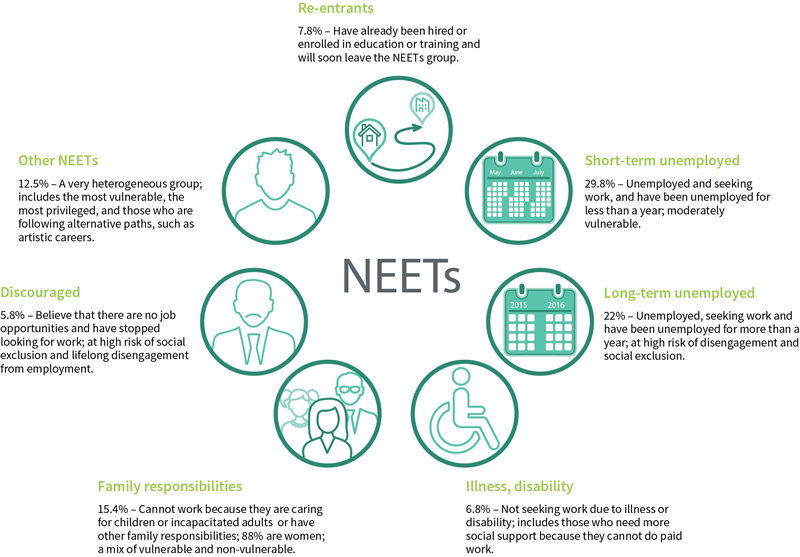EU context
Sąvoka plačiai vartojama kaip rodiklis, kuriuo remiantis nuo 2010 m. formuojama į jaunimą orientuota įsidarbinamumo, išsilavinimo bei mokymo ir socialinės įtraukties politika 28 ES valstybėse narėse.
Sąvoka nedirbantis ir nesimokantis jaunimas pirmą kartą pavartota Europos politinėse diskusijose dėl strategijos „Europa 2020“ pavyzdinės iniciatyvos „Judus jaunimas“. Sąvoka taikoma 15–24 metų jaunimui, o vėliau buvo praplėsta, kad apimtų 15–29 metų jaunus žmones. Dabar sąvoka ES lygmeniu įtvirtinta politiniame diskurse. Šiuo metu 14,2 proc. gyventojų, kurių amžius yra 15–29 metai, priklauso nedirbančio ir nesimokančio jaunimo grupei.
2013 m. balandžio mėn. buvo priimtas Europos Sąjungos Tarybai skirtas Europos Komisijos pasiūlymas visose valstybėse narėse įgyvendinti jaunimo garantijų iniciatyvas. Nedirbančio ir nesimokančio jaunimo skaičiaus mažinimas yra aiškus jaunimo garantijų politinis tikslas. Šia iniciatyva siekiama užtikrinti, kad visi 15–29 metų jaunuoliai gautų kokybišką įdarbinimo, tęstinio mokymo, pameistrystės ar stažuotės pasiūlymą per keturis mėnesius nuo tada, kai tampa bedarbiais ar užbaigia formalųjį mokymąsi. Jaunimo garantijų įgyvendinimas valstybėse narėse per Jaunimo garantijų iniciatyvą padėjo gerinti padėtį vietoje ir sumažinti nedirbančio ir nesimokančio jaunimo skaičių.
Visai neseniai, 2016 m. gruodžio 7 d., Europos Komisija pradėjo iniciatyvą „Investicijos į Europos jaunimą“, rodančią atnaujintas pastangas remti jaunimą. Atsižvelgdama į teigiamą jaunimo garantijų poveikį iki šiol, Komisija siekia skatinti ir didinti Jaunimo užimtumo iniciatyvai prieinamas lėšas iki 2020 m., kad paskatintų veiksmingesnį jaunimo įsitraukimą.
EUROFOUND atliktas darbas
Įgyvendinant jaunimo garantijas šiek tiek sumažėjo 15–29 metų nedirbančių ir nesimokančių jaunuolių skaičius: nuo apytiksliai 14 mln. krizės įkarštyje iki 12,5 mln. 2016 m. (14,2 proc.). Vis dėlto iš EUROFOUND tyrimų vis dar matyti, kad Europa patiria didelių ekonominių nuostolių, kurių vertė siekia apie 142 mlrd. EUR per metus (2015 m.); juos sudaro prarastos pajamos ir nesumokėti mokesčiai. Tai turi svarbų poveikį ES ekonominiam ir socialiniam vystymuisi.
Svarbiausias indėlis
Iki šiol EUROFOUND atliko pavyzdinius išsamius tyrimus, susijusius su nedirbančiu ir nesimokančiu jaunimu (žr. leidinius toliau), taip pat:
- atliko pirmą ES lyginamąją analizę, susijusią su nedirbančiu ir nesimokančiu jaunimu;
- paaiškino, kas yra nedirbantis ir nesimokantis jaunimas;
- įvertino ekonomines išlaidas, susijusias su nedirbančiu ir nesimokančiu jaunimu;
- tyrė socialines pasekmes, kurias patiria nedirbantis ir nesimokantis jaunimas;
- įvertino rizikos veiksnius, kurie priskiriami nedirbančio ir nesimokančio jaunimo kategorijai;
- ištyrė nedirbančio ir nesimokančio jaunimo reintegravimo politikos veiksmingumą;
- stebėjo jaunimo garantijų įgyvendinimą.
Nedirbančio ir nesimokančio jaunimo įvairovė
Atlikdamas šį tyrimą, EUROFOUND siekė atskleisti nedirbančio ir nesimokančio jaunimo įvairovę. Naujausiame tyrime apie nedirbančio ir nesimokančio jaunimo įvairovę, siekiant geriau suprasti šios jaunimo grupės sudėtį, pateikiamas naujas suskirstymas į septynis pogrupius. Taip siekiama geriau padėti politikos formuotojams suprasti, kas sudaro nesimokantį ir nedirbantį jaunimą, ir padėti kurti tinkamas paramos priemones, kurios atitiktų plačią poreikių įvairovę. Kiekvieną iš šių grupių sudaro pažeidžiamo ir nepažeidžiamo jaunimo, kurie nesukaupia žmogiškojo kapitalo per oficialius kanalus, derinys, nepaisant to, ar taip atsitinka dėl jų kaltės ar ne.
Kitos tyrimų temos
Be minėto tyrimo, pastaraisiais metais EUROFOUND nagrinėjo (žr. leidinius toliau):
- jaunimo verslumo savybes ir vertybes;
- kaip įtraukti „trūkstamą vidurį“: antrosios pakopos mokyklinį išsilavinimą turintį jaunimą, kuris nesiekia aukštojo išsilavinimo;
- jaunimo socialinės įtraukties klausimus;
- jaunimo perėjimą į darbo rinką;
- laikino jaunimo užimtumo padidėjimą ir galimybę naudotis socialine apsauga;
- jaunų darbo rinkos dalyvių darbo sąlygas;
- naujausius politinius pokyčius, susijusius su nedirbančiu ir nesimokančiu jaunimu.
Žr. toliau pateiktą leidinių sąrašą.
Susijusi medžiaga: nedirbančio ir nesimokančio jaunimo grupei būdingos įvairovės tyrimas
2016 m. liepos 4 d. – Remiantis 2012 m. EUROFOUND ataskaita Nedirbantis ir nesimokantis jaunimas – darbo neturintis jaunimas, šiame tyrime nagrinėjama nedirbančio ir nesimokančio jaunimo įvairovė, panaudojant septynis siūlomus pogrupius, į kuriuos galima suskirstyti nedirbantį ir nesimokantį jaunimą, ir panaudojant 2013 m. Europos darbuotojų tyrimo metu gautus duomenis. Šie pogrupiai sudaro sąlygas atlikti išsamesnę analizę, kaip politika, socialinis klimatas ir lėtas, bet laipsniškas darbo rinkos gerėjimas paveikė nedirbantį ir nesimokantį jaunimą 28 ES valstybėse narėse. Jie padeda nustatyti, ką galima padaryti siekiant išspręsti klausimą, kai, pvz., ilgalaikis nedarbas yra paveikęs 22 procentus 15–24 metų nedirbančio ir nesimokančio jaunimo. 28 šalių informacijos suvestinės apie nedirbančio ir nesimokančio jaunimo įvairovę taip pat yra prieinamos ir jose pateikiama trumpa nedirbančio ir nesimokančio jaunimo padėties valstybėse narėse apžvalga. Šioje informacijoje nagrinėjamos jaunimo nedarbo tendencijos, nedirbančių ir nesimokančių jaunuolių skaičius, nedirbančio ir nesimokančio jaunimo grupės sudėtis ir tokiems jaunuoliams kylanti socialinės atskirties rizika.
Nesimokančio ir nedirbančio jaunimo grupei būdingos įvairovės tyrimas.
Nedirbantis ir nesimokantis jaunimas. Infografikas.













